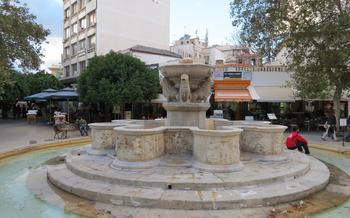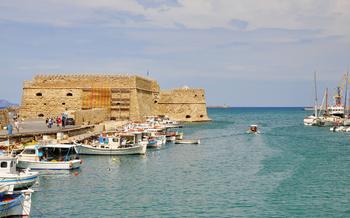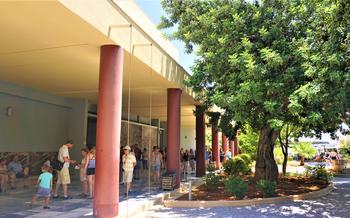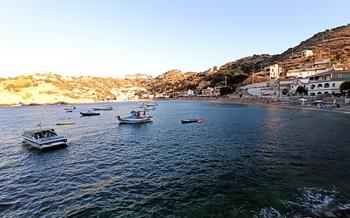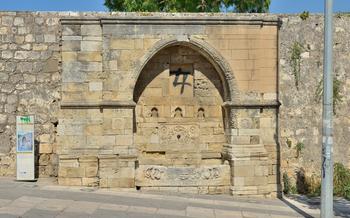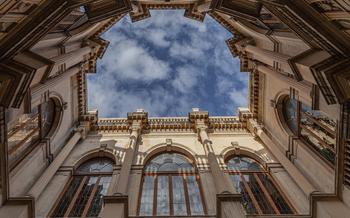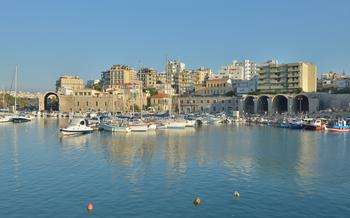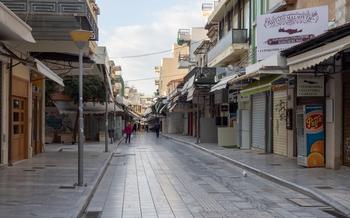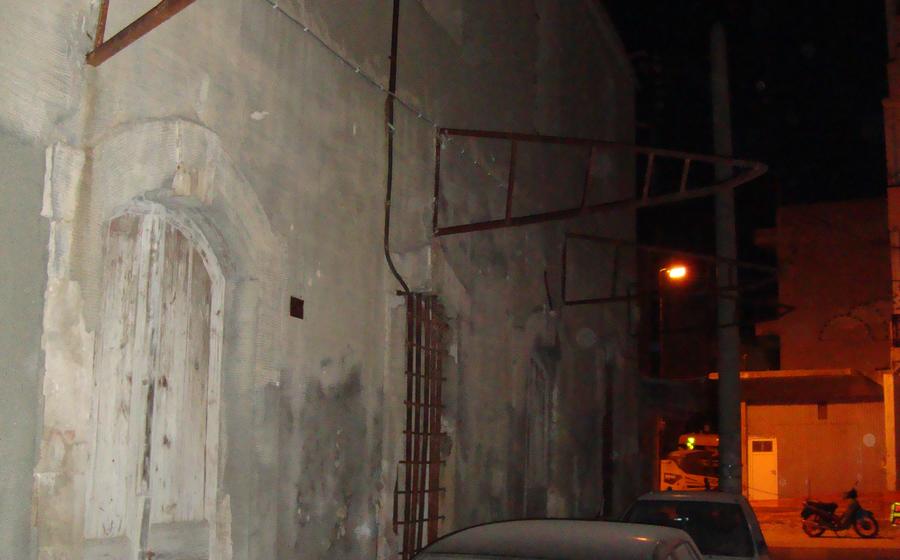
Venetian Shipyard at Morosini Harbour
- History of the Venetian Shipyard:
- Location
- Exploration
- Artifacts and Exhibits
- Guided Tours: Unveiling the Secrets of Venetian Shipbuilding
- Restoration and Preservation:
- Venetian Architecture and Design
- Historical Context
- Shipbuilding Techniques
- Maritime History
- Educational Value
- Photographic Opportunities:
- Souvenirs and Shopping
- Nearby Attractions
- Insider Tip:
History of the Venetian Shipyard:
The Venetian Shipyard at Morosini Harbour, a testament to the maritime prowess of the Venetian Republic, stands as a reminder of Crete's rich historical tapestry. Constructed in the 13th century under Venetian rule, the shipyard played a pivotal role in supporting the Venetian navy's dominance in the Mediterranean. For over four centuries, it served as a hub for shipbuilding, repairs, and maintenance, contributing significantly to Venice's maritime power and influence.
The shipyard's strategic location, coupled with its advanced facilities and skilled workforce, made it a vital asset to the Venetian fleet. Ships constructed and repaired here sailed far and wide, engaging in trade, exploration, and military campaigns. The shipyard's contributions were instrumental in maintaining Venice's maritime supremacy, facilitating its expansion and shaping the course of maritime history in the Mediterranean region.
Location
The Venetian Shipyard at Morosini Harbour is situated in the heart of Heraklion, on the island of Crete, in Greece. It is located at the western end of the harbour, near the old city walls and the Venetian fortress. The shipyard is easily accessible by foot, as it is just a short walk from the city centre and other popular tourist attractions. Visitors can also reach the shipyard by taking a taxi or using public transportation, such as buses or trams, which stop nearby.
Exploration
The Venetian Shipyard at Morosini Harbour is a fascinating site to explore, offering a glimpse into the past and the ingenuity of Venetian shipbuilding. The shipyard's layout is well-organized, with dry docks, workshops, and storage areas arranged in a logical manner. Visitors can wander through the shipyard, admiring the impressive stone structures and imagining the bustling activity that once took place here.
Key areas to explore include:
-
Dry Docks: The shipyard features several dry docks, which were used to construct and repair ships. These large, rectangular basins were designed to allow ships to be pulled out of the water for maintenance and repairs.
-
Workshops: The shipyard also contains a number of workshops, where shipwrights and other craftsmen worked on constructing and repairing ships. These workshops were equipped with a variety of tools and equipment, and the air would have been filled with the sounds of hammering, sawing, and other shipbuilding activities.
-
Storage Areas: The shipyard also includes several storage areas, where materials and supplies were kept. These areas would have been essential for keeping the shipyard running smoothly, and they provide a glimpse into the logistics of shipbuilding in the Venetian era.
Exploring the Venetian Shipyard is a unique and rewarding experience, allowing visitors to step back in time and witness the ingenuity and craftsmanship of the Venetian shipbuilders.
Artifacts and Exhibits
The Venetian Shipyard at Morosini Harbour houses a collection of artifacts and exhibits that offer a deeper insight into the shipbuilding and naval activities of the Venetian era. Among the notable artifacts, visitors can find various tools used in the construction and repair of ships, including hammers, chisels, and saws. There are also remnants of shipwrecks, such as anchors, cannons, and pieces of wooden hulls, which provide a glimpse into the fate of some of the vessels that were built or repaired at the shipyard.
Interactive exhibits and displays further enhance the visitors' understanding of the shipyard's operations. These exhibits incorporate multimedia presentations, touchscreens, and interactive models that demonstrate the processes of shipbuilding and the functioning of various naval technologies. Visitors can learn about the different types of ships that were built at the shipyard, the materials used in their construction, and the techniques employed by Venetian shipwrights. Through these interactive displays, the shipyard becomes a living museum, where visitors can engage with the past and gain a deeper appreciation for the craftsmanship and ingenuity of the Venetian shipbuilders.
Guided Tours: Unveiling the Secrets of Venetian Shipbuilding
To fully appreciate the historical significance and intricacies of the Venetian Shipyard, consider embarking on a guided tour. These informative excursions, led by knowledgeable guides, provide an immersive experience that brings the shipyard's past to life.
Guided tours are available in various languages, ensuring that visitors from different linguistic backgrounds can delve into the shipyard's rich history. Expert guides share captivating tales of the shipyard's origins, its role in Venetian naval power, and the shipbuilding techniques employed during that era.
These guided tours offer an in-depth understanding of the shipyard's layout, allowing visitors to explore key areas such as the dry docks, workshops, and storage facilities. Guides provide detailed explanations of the processes involved in constructing and repairing ships, shedding light on the remarkable craftsmanship and ingenuity of Venetian shipbuilders.
By participating in a guided tour, visitors gain a deeper appreciation for the Venetian Shipyard's pivotal role in shaping the maritime history of Greece and the Mediterranean region. These tours provide a unique opportunity to step back in time and witness the legacy of Venetian naval power through the lens of this remarkable shipyard.
Restoration and Preservation:
The Venetian Shipyard at Morosini Harbour has undergone extensive restoration and preservation efforts to maintain its historical integrity. Recognizing its significance, authorities and conservationists have collaborated to restore damaged structures, reinforce foundations, and preserve the shipyard's original features.
One of the challenges faced in this process is the need to balance restoration with the preservation of the shipyard's authenticity. While the goal is to restore the shipyard to its former glory, it is crucial to retain its historical character and avoid modern interventions that could compromise its original design.
Skilled artisans and conservators have meticulously worked to repair and restore the shipyard's walls, arches, and dry docks, using traditional techniques and materials. This delicate process ensures that the shipyard remains a testament to Venetian craftsmanship and engineering.
The restoration efforts have not only preserved the shipyard's physical structures but have also extended to the surrounding environment. Landscaping and vegetation have been carefully planned to recreate the original ambiance of the shipyard, providing visitors with an immersive experience that transports them back in time.
The ongoing restoration and preservation efforts at the Venetian Shipyard at Morosini Harbour demonstrate a commitment to safeguarding this valuable historical site for future generations. By preserving its authenticity and showcasing its unique features, the shipyard continues to serve as a poignant reminder of Heraklion's rich maritime heritage and the enduring legacy of Venetian rule.
Venetian Architecture and Design
The Venetian Shipyard at Morosini Harbour is a testament to the architectural prowess and innovative design principles of the Venetian Republic. The shipyard's layout reflects the Venetians' mastery of urban planning and their focus on efficiency. The dry docks, workshops, and other facilities are arranged in a logical and orderly manner, maximizing the use of space and facilitating the movement of materials and personnel.
The shipyard's architecture showcases the distinctive Venetian Gothic style, characterized by pointed arches, ribbed vaults, and intricate stonework. The use of arches and vaults creates a sense of height and grandeur, while the intricate carvings and decorative elements add a touch of elegance and sophistication. The shipyard's walls are adorned with the Lion of Saint Mark, the symbol of the Venetian Republic, further emphasizing its Venetian heritage.
The shipyard's design also reflects Venetian principles of fortification and defense. The thick walls and strategically placed towers provided protection against potential attacks from enemies. The shipyard's location within the larger fortifications of Heraklion further enhanced its security.
Overall, the Venetian Shipyard at Morosini Harbour is a remarkable example of Venetian architecture and design. Its layout, style, and defensive features all reflect the ingenuity and expertise of the Venetian Republic, making it a valuable historical and architectural landmark.
Historical Context
The Venetian Shipyard at Morosini Harbour played a pivotal role in the context of Venetian maritime trade. As a crucial hub for shipbuilding and naval activities, it contributed significantly to the flourishing of trade and commerce throughout the Mediterranean region. The shipyard's strategic location facilitated efficient transportation of goods and resources between Venice and its vast network of trading partners. Moreover, its proximity to major trade routes allowed Venetian merchants to capitalize on lucrative opportunities and expand their commercial reach.
The shipyard's strategic importance extended beyond trade, as it also played a key role in supporting Venetian naval power. During times of conflict, the shipyard served as a vital base for constructing and repairing warships, ensuring the strength and readiness of the Venetian fleet. This enabled Venice to maintain its dominance in naval warfare and safeguard its maritime interests throughout the Mediterranean.
Shipbuilding Techniques
The Venetian Shipyard at Morosini Harbour showcases traditional shipbuilding methods that have been passed down through generations. Visitors can learn about the intricate processes involved in constructing and repairing ships using these time-honored techniques. The shipyard's skilled craftsmen employed various tools and materials, including wood, rope, and metal, to create sturdy and seaworthy vessels.
One of the key techniques used was carvel construction, where planks were attached to the ship's frame using nails or wooden pegs. This method ensured a strong and durable hull that could withstand the rigors of long sea voyages. Shipwrights also employed caulking to seal the seams between the planks, preventing water from seeping in.
The shipyard also utilized traditional rigging systems, relying on ropes and pulleys to control the ship's sails. These systems allowed for efficient maneuvering and enabled ships to harness the power of the wind to navigate the vast Mediterranean Sea.
Visitors to the shipyard can gain insights into the evolution of shipbuilding practices over time. From the early days of wooden sailing ships to the introduction of more advanced technologies, the shipyard serves as a testament to the ingenuity and craftsmanship of Venetian shipbuilders.
Maritime History
The Venetian Shipyard at Morosini Harbour stands as a testament to the rich maritime history of Greece. During the Venetian era, the shipyard played a pivotal role in the development of the island's seafaring traditions. It was here that skilled craftsmen constructed and repaired ships, contributing to the growth of Crete's maritime trade and naval prowess.
The shipyard's strategic location on the northern coast of Crete made it an ideal base for Venetian naval operations in the Mediterranean. Ships built and maintained at Morosini Harbour sailed across the seas, carrying goods, people, and ideas. The shipyard's contributions to maritime trade and exploration helped to shape the cultural and economic landscape of the region.
Today, the shipyard serves as a reminder of Greece's deep-rooted maritime heritage. Its well-preserved structures and artifacts provide a glimpse into the ingenuity and craftsmanship of Venetian shipbuilders. Visitors can explore the shipyard's dry docks, workshops, and other facilities, gaining insights into the processes and techniques used to construct and maintain wooden sailing ships.
The Venetian Shipyard at Morosini Harbour is a valuable site for understanding the maritime history of Greece. It is a place where visitors can learn about the island's seafaring traditions, appreciate the skills of Venetian shipbuilders, and explore the legacy of one of the most important shipyards in the Mediterranean.
Educational Value
The Venetian Shipyard at Morosini Harbour is not merely a historical relic; it serves as a valuable educational resource, offering a glimpse into the rich maritime history of Greece and the shipbuilding practices of the Venetian era. The shipyard provides an immersive learning experience for visitors of all ages, fostering an appreciation for the ingenuity and craftsmanship that went into constructing and maintaining Venetian vessels.
Researchers and students of maritime history find the shipyard to be a treasure trove of information. The well-preserved structures, artifacts, and exhibits offer insights into the shipbuilding techniques, maritime trade routes, and naval strategies of the Venetian Republic. The shipyard's historical significance extends beyond its role in Venetian maritime power; it also sheds light on the broader context of Mediterranean trade and cultural exchange during the Middle Ages.
For those seeking a deeper understanding of shipbuilding and maritime history, the Venetian Shipyard offers a unique opportunity to explore the intricate details of ship construction, from the selection of materials to the assembly of the vessels. Interactive exhibits and displays bring the shipyard's past to life, allowing visitors to engage with the tools, techniques, and processes used by Venetian shipwrights.
Photographic Opportunities:
The Venetian Shipyard at Morosini Harbour offers a wealth of photographic opportunities for visitors who love to capture the essence of history through their lenses. The shipyard's picturesque setting, with its weathered stone walls, arched doorways, and intricate carvings, provides a stunning backdrop for memorable shots.
One of the most popular spots for photography is the main courtyard of the shipyard, where visitors can capture the grandeur of the surrounding structures and the impressive dry docks. The dry docks, with their distinctive arched vaults, are particularly photogenic, especially when bathed in the warm glow of the Mediterranean sun.
Another great spot for photography is the shipyard's workshop area, where visitors can capture the intricate details of the tools and equipment used by Venetian shipbuilders. The old anvils, forges, and woodworking benches provide a glimpse into the craftsmanship and ingenuity of the past.
For those who love to capture the beauty of the sea, the shipyard's harbor offers breathtaking views of the sparkling turquoise waters and the distant coastline. The contrast between the ancient shipyard and the vibrant blue of the sea creates a stunning visual that is sure to impress.
Whether you're a professional photographer or simply someone who loves to capture special moments, the Venetian Shipyard at Morosini Harbour is a treasure trove of photographic opportunities. So, don't forget to bring your camera and capture the timeless beauty of this historic site.
Souvenirs and Shopping
As you stroll through the Venetian Shipyard at Morosini Harbour, you'll uncover a treasure trove of souvenirs and shopping opportunities that capture the essence of maritime history and craftsmanship. Local artisans and shops line the streets, showcasing unique handicrafts and mementos that pay homage to the shipyard's legacy.
From intricate model ships that replicate the grandeur of Venetian vessels to handcrafted jewelry inspired by the shipyard's architectural details, there's something for every taste and budget. Discover hand-painted pottery adorned with maritime motifs, or browse through racks of clothing featuring designs that evoke the spirit of seafaring.
For those seeking a truly authentic souvenir, consider purchasing a replica of a traditional shipbuilding tool or a piece of antique navigational equipment. These treasures will serve as tangible reminders of the shipyard's rich history and the ingenuity of its craftsmen.
As you make your purchases, remember that you're not just buying a souvenir; you're supporting the local community and preserving the legacy of the Venetian Shipyard. Each item you take home carries a piece of the shipyard's story, ensuring that its heritage continues to live on.
Nearby Attractions
The Venetian Shipyard is surrounded by a wealth of historical and cultural attractions, offering visitors the chance to delve deeper into the rich heritage of Heraklion and Crete. A short walk from the shipyard, visitors can explore the impressive Koules Fortress, a towering Venetian fortification that guarded the entrance to the port. The fortress now serves as a captivating museum, showcasing its fascinating history and offering panoramic views of the city and the Mediterranean Sea.
Another nearby attraction is the Archaeological Museum of Heraklion, renowned for housing one of the world's most significant collections of Minoan artifacts. Visitors can marvel at the exquisite frescoes and sculptures unearthed from the ancient Minoan palaces, gaining insights into the vibrant civilization that flourished on Crete thousands of years ago.
For those interested in religious history, the St. Titus Church is a must-visit. This grand Venetian-Gothic cathedral is dedicated to the patron saint of Heraklion and features stunning architecture, intricate mosaics, and a sacred atmosphere that invites contemplation and reflection.
Combining a visit to the Venetian Shipyard with these nearby attractions allows visitors to immerse themselves in the diverse cultural tapestry of Heraklion. Whether exploring the maritime heritage of the shipyard, delving into the depths of Minoan civilization, or experiencing the spiritual essence of the city's religious landmarks, there is something for every traveler to discover in this vibrant and historic destination.
Insider Tip:
Unveiling the secrets of the Venetian Shipyard at Morosini Harbour requires careful planning for an exceptional experience. To truly immerse yourself in the shipyard's allure, consider visiting during the shoulder seasons – spring or autumn – when the crowds are fewer, allowing you to wander freely and soak in the tranquility of the site. This serene atmosphere provides ample opportunity for contemplation and deeper appreciation of the shipyard's historical significance.
Combine your visit to the shipyard with a leisurely stroll along the picturesque Venetian Harbour, just a stone's throw away. Admire the majestic Venetian fortifications and soak in the charm of the old town with its narrow streets, vibrant tavernas, and unique shops. Indulge in the local cuisine and savor the flavors of traditional Cretan dishes, paired with a glass of refreshing ouzo.
Extend your exploration by venturing beyond the shipyard and discovering other hidden gems in Heraklion. Visit the Heraklion Archaeological Museum, home to a world-renowned collection of Minoan artifacts, including the iconic Minoan Snake Goddess. Immerse yourself in the history and culture of Crete as you wander through the museum's captivating exhibits. Take advantage of the opportunity to explore the Venetian Walls, which encircle the city, offering breathtaking panoramic views of Heraklion and the surrounding landscape.
